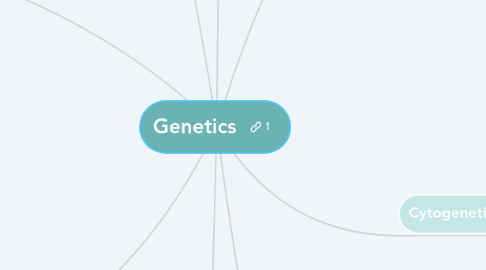
1. Human genome
1.1. XX → Female XY → Male
1.2. Chromosomes
1.2.1. 46 chromosomes in total
1.2.2. 23 pairs of chromosomes
1.2.3. 1 pair of sex chromosomes
1.2.4. 22 pairs of autosomes
1.3. 22,500 genes in total
1.4. The genome is a complete set of hereditary information encoded by genetic material (DNA)
1.5. The gene locus is the location of a gene on a chromosome
1.6. Mitochondrial DNA always inherited from mother
2. Chromatin organisation
2.1. First level:
2.1.1. fundamental unit of DNA packaging
2.1.2. 147 base pair stretch of DNA coiled around histone octomer
2.1.3. adjacent histones connected by linker DNA
2.1.4. string of beads structure
2.2. Second level:
2.2.1. string of beads is repeatedly looped and coiled to form a solenoid
2.2.2. histone H1 acts as a clamp preventing coiled DNA detaching from nucleosome
2.3. Third level:
2.3.1. loops of 30nm solenoids are attached to a scaffold consisting of non-histone acidic proteins
2.3.2. forms radial loop structure
3. Cell cycle
3.1. Interphase
3.1.1. G1 - growth and metabolism
3.1.2. S phase - DNA replication
3.1.3. G2 - mitosis preparation
3.2. Mitosis
3.2.1. prophase
3.2.1.1. nuclear membrane degrades, chromosomes condense
3.2.2. prometaphase
3.2.2.1. spindles attach to chromosomes
3.2.3. metaphase
3.2.3.1. chromosomes align on metaphase plate/cell equator
3.2.4. anaphase
3.2.5. chromatids are pulled to opposite cell poles, centromere splits
3.2.6. telophase
3.2.6.1. nuclear membrane reforms, spindles disappear
3.2.7. cytokinesis
3.2.7.1. division of the cytoplasm
3.3. Meiosis
3.4. Mitosis & meiosis...
3.4.1. mitosis → produces genetically identical daughter cells. meiosis → produces genetically different daughter cells.
3.4.2. mitosis → produces diploid cells meiosis → produces haploid cells
3.4.3. mitosis → prophase is quick meiosis → prophase is extensive
4. Karyotypes
4.1. Shows metaphase chromosomes arranged in pairs according to size
4.2. Can reveal...
4.2.1. gender
4.2.2. infertility problems
4.2.3. chromosome number and size
4.3. How to produce a karyotype:
4.3.1. dividing cells arrested during metaphase using colchicine (mitotic inhibitor that prevents spindle fibre formation)
4.3.2. cells swell in a hypotonic solution
4.3.3. cells then fixed in methanol acetic acid to preserve structure
4.3.4. the cells burst to release metaphase chromosomes on a slide
5. Chromosome structure
5.1. Short p arm, long q arm
5.2. Telomeres:
5.2.1. contain repeat TTAGGG sequences
5.2.2. located at the ends of chromosome arms
5.2.3. maintain structural integrity
5.2.4. degrade with age
5.2.5. without telomeres, chromosomes are unstable and may fuse together
5.3. Centromeres:
5.3.1. the most constricted part of the chromosome
5.3.2. joins the two chromatids
5.3.3. contains the kinetochore where spindle fibres attach
5.3.4. centromere is pulled towards opposite poles in mitosis
5.4. Lighter bands on chromosomes called euchromatin where genes are expressed. Darker bands called heterochromatin where genes are not expressed.
5.5. Structure is classified by location of centromere:
5.5.1. telocentric → centromere located at telomeres, no p arms
5.5.2. acrocentric → centromere located near telomeres, p arms are very short
5.5.3. submetacentric → centromere not quite central, p arms are shorter than q arms
5.5.4. metacentric → centromere roughly central, p and q arms are similar in length
5.5.5. acentric → no centromere
6. Genetic disorders
6.1. Chromosome abnormalities:
6.1.1. repeat sequences → repetition of nucleotides or whole genes
6.1.2. single gene mutations → point mutations or changes in a gene
6.1.3. multifactorial disorders → mutations in multiple genes
6.2. Polyploidy
6.2.1. whole set of chromosomes in duplicated
6.2.2. always lethal in humans
6.2.3. Triploid (3n):
6.2.3.1. most common type of polyploidy
6.2.3.2. mostly caused by dispermy (2 sperm fertilising 1 ovum)
6.2.4. Tetraploid (4n):
6.2.4.1. can occur due to failure of cell division
6.2.4.2. 4n
6.3. Aneuploidy
6.3.1. the loss/gain of individual chromosomes
6.3.1.1. monosome =chromosome has missing homologous partner
6.3.1.2. trisomy = chromosome has addition homolog
6.3.1.2.1. Trisomy of sex chromosomes is compatible with life, but will cause phenotypic abnormalities. Trisomy of autosomes does not usually permit survival, but there are some that do. Trisomy 21 → gain of an extra chromosome 21, results in Down's syndrome. May have trisomy of other chromosomes, eg. trisomy 13/18
6.3.1.3. hypoploidy = missing chromosomes
6.3.1.4. hyperploidy = extra chromsomes
6.3.2. caused by
6.3.2.1. non-disjunction (failure of chromosomes to separate during cell division)
6.3.2.2. anaphase lag
6.4. Mosaicism
6.4.1. caused by mitotic errors
6.4.2. when an individual is composed of cells of two genetically different types
6.4.3. Mosaic Turner Syndrome → affected people have normal sex chromosomes but other cells have only one copy of X chromosome
6.4.4. Autosomal Mosaicism is more rare
7. Cytogenetics
8. Chromosomal aberrations
8.1. deletions
8.2. translocations
8.2.1. Balanced robertsonian Translocation

